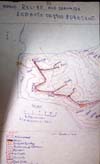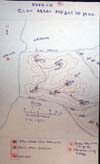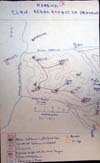|
Location Index
0.1
|
| Mubimambila Essays |
 |
 |
 |

|
| Yarbil, Mohammed M. Mambilla Division Ndarup Village Department of Geography, Teacher's College, Mubi Unpublished Local Study |
|
Ndarup: 5 Quarters of common
origin plus 3= Swia, Kung and Nuwa made by Local
Authy, but they are under Warwar. 8 Origin from Kimi. some have gone from Ndarup to Lekitaba and Karara. Rect. houses began in 1960's now many still round but bricks not pudddled mud. 15 Forest owned by quarters eg forest at Suah belongs to Swap people, callled Yirum Shua. 24 Big male juju, small male juju= suwa tilla. Man affected by Makka could walk up trees. 25 "Makka could affect every young man who was thought to be good and genuine. He could climb any tree with any part of his body, run very faster, spoke out his dreams which were believed to be sent by God through him and he could tell what was to happen in the future. He ran about nakedly and some times he could become normal. They had special centres for practicing all these and the places concentrated at Gwii." 26 dances = Mbiter Kati, Buol, Titeng and Ndil. Used to each have their own season, now some defunct, others such as Mbiter can happen at any time. Male seeing female juju became impotent, female seeing male juju ruins her life unless special medicine given. 28 To E of the villlage is rock callled bal Nvur Kal. This once had big cave beneath it. 29 People used to hide from germans there. Fossils etc in it! To SE is bar tou where leopards used to live. At Nkuwa is mammy water cave, mammy water like goat lived there. Once upon a time woman refused to use a grindstone brought from the cave, and the whole area filled with water because of her anger.
|
|
|
|
© Copyright 2006 Kent University & the Author |